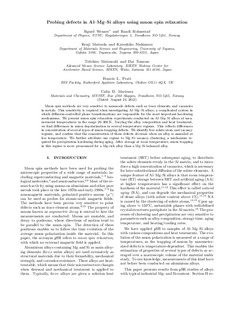| dc.contributor.author | Wenner, Sigurd | |
| dc.contributor.author | Holmestad, Randi | |
| dc.contributor.author | Matsuda, Kenji | |
| dc.contributor.author | Nishimura, K. | |
| dc.contributor.author | Matsuzaki, T | |
| dc.contributor.author | Tomono, D | |
| dc.contributor.author | Pratt, FL | |
| dc.contributor.author | Marioara, Calin Daniel | |
| dc.date.accessioned | 2018-02-06T09:54:14Z | |
| dc.date.available | 2018-02-06T09:54:14Z | |
| dc.date.created | 2012-11-20T11:04:44Z | |
| dc.date.issued | 2012 | |
| dc.identifier.citation | Physical Review B. Condensed Matter and Materials Physics. 2012, 86 (10), . | nb_NO |
| dc.identifier.issn | 1098-0121 | |
| dc.identifier.uri | http://hdl.handle.net/11250/2482879 | |
| dc.description.abstract | Muon spin methods are very sensitive to nanoscale defects such as trace elements and vacancies in metals. This sensitivity is required when investigating Al-Mg-Si alloys, a complicated system in which diffusion-controlled phase transformations are responsible for the most important hardening mechanisms. We present muon spin relaxation experiments conducted on Al-Mg-Si alloys at measurement temperatures in the range 20–300 K. Varying the alloy composition and heat treatment, we find differences in muon depolarization in several temperature regimes. This reflects differences in concentration of several types of muon-trapping defects. We identify free solute atom and vacancy regimes, and confirm that the concentration of these defects decreases when an alloy is annealed at low temperature. We further attribute one regime to Mg-Si vacancy clustering, a mechanism required for precipitation hardening during aging. After storage at room temperature, muon trapping in this regime is more pronounced for a Mg-rich alloy than a Mg-Si-balanced alloy. | nb_NO |
| dc.language.iso | eng | nb_NO |
| dc.publisher | American Physical Society | nb_NO |
| dc.title | Probing defects in Al-Mg-Si alloys using muon spin relaxation | nb_NO |
| dc.type | Journal article | nb_NO |
| dc.type | Peer reviewed | nb_NO |
| dc.description.version | acceptedVersion | nb_NO |
| dc.source.pagenumber | 7 | nb_NO |
| dc.source.volume | 86 | nb_NO |
| dc.source.journal | Physical Review B. Condensed Matter and Materials Physics | nb_NO |
| dc.source.issue | 10 | nb_NO |
| dc.identifier.doi | 10.1103/PhysRevB.86.104201 | |
| dc.identifier.cristin | 963502 | |
| dc.relation.project | Norges forskningsråd: 193619 | nb_NO |
| dc.description.localcode | © 2012. This is the authors' accepted and refereed manuscript to the article. The final authenticated version is available online at: https://journals.aps.org/prb/abstract/10.1103/PhysRevB.86.104201 | nb_NO |
| cristin.unitcode | 194,66,20,0 | |
| cristin.unitname | Institutt for fysikk | |
| cristin.ispublished | true | |
| cristin.fulltext | postprint | |
| cristin.qualitycode | 0 | |
